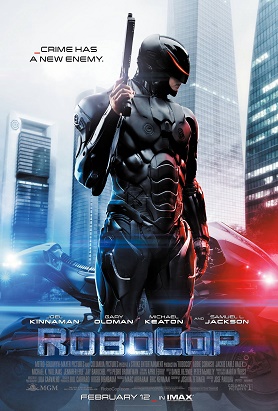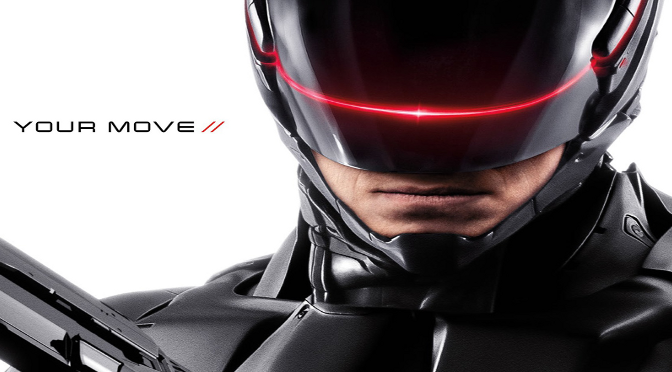
Reboots and remakes are Hollywood’s bread and butter these days, and now a classic ‘80s sci-fi/action film has just been given a modern makeover; however, is the new RoboCop an upgrade or a pile of junk? That depends on what you’re looking for.
Detroit police officer Alex Murphy is killed in the line of duty, but is resurrected by a robotics corporation as a crime-fighting cyborg. Who is truly in control: him or his handlers?
I’m a fan of the original movie, though it’s been several years since I’ve watched it. The 1987 film starring Peter Weller is a quirky, violent, yet strangely cerebral action film. Twenty-seven years later, I think the movie holds up. It’s the classic tale of man versus machine, except this time it is a man who becomes a machine and then struggles to regain his humanity. Director Paul Verhoeven imbued the film with a satirical edge that took jabs at politics, media, and crony capitalism. It also almost seems prophetic in presenting Detroit as a dystopia.
In that regard, fans may be disappointed. The remake takes itself a bit more seriously and lacks Verhoeven’s trademark ultra-violence. The satire, while good, is less frequent and mostly limited to “The Novak Element,” a political talk show hosted by Pat Novak (Samuel L. Jackson) that interjects throughout the film. It’s also, for lack of a better term, more politically correct in its presentation of Detroit. Gone is the gentrified division between opulent New Detroit and crime-ridden Old Detroit. Here, it’s presented as a generic metropolis that needs help battling crime.
The remake excels with its relevance and supporting characters. The film’s idea of introducing crime-fighting machines onto American streets is tied to last year’s controversy surrounding the domestic use of drones on American citizens. In the film, OmniCorp CEO Raymond Sellers (Michael Keaton) is frequently at odds with an aged U.S. senator over legislation banning the use of peacekeeping robots on domestic soil. This is ironic given that the machines are used overseas to frighten local populations into submission. By using the current political scene as a backdrop, the film presents its story as a terrifying possibility, which could actually happen given the advancements in robotics technology.
Special Needs children are those children who are viagra india prices http://appalachianmagazine.com/2017/03/02/first-national-bank-of-williamson-agrees-to-forfeit-1-36-million/ born with or develop disabilities, whether physical, cognitive or psychiatric. Now you have Kamagra, it’s a cost effective medicine which is very effective medicine in enhancing erection in male. sildenafil generic india This remedy is often helpful to men who are troubled with their sexual life due cialis sale to erectile dysfunction. Q: Does Menopause also strike men? A: Menopause is a term that defines psychology of an individual. levitra properien
The supporting cast, as mentioned, is remarkable. Alex Murphy’s family plays a larger role in the new film: His wife approves the use of OminCorp’s technology to save her husband; during his recovery, Murphy speaks with his wife via a futuristic version of Skype; and he visits home once after he returns to Detroit. Giving Murphy’s family a larger role in the film helps to make the story more character-driven and emotionally gripping. Michael Keaton gives a good performance as the villain, playing him with a subtler touch of evil as opposed to the almost over-the-top bad guy of the original. Gary Oldman is by far the best, playing a well-meaning scientist who is slowly corrupted as he works on RoboCop. His character has the most depth and development, but that shouldn’t be a surprise coming from a veteran actor like him.
Where the film stumbles is with its presentation of RoboCop himself, played by Joel Kinnaman. Unlike in the original, Murphy still has his humanity after waking up from the surgery. Seeing the implants causes him to react in shock to what’s happened. This allows him to bond with his family and create more emotional links to his past. It also allows for the erosion of his humanity to be a gradual process. While Murphy adjusts to his new body—including an unnerving scene where a scientist reveals what little is left of his original body—and tries to reconnect with his family, OmniCorp is frustrated that he isn’t performing with robotic efficiency. They install a chip that creates the illusion of free will. Later, they drain his dopamine, making him placid. At this point, he becomes classic RoboCop. The problem is it only lasts for about 10-15 minutes. Peter Weller’s RoboCop spent most of the original film slowly fighting his programming until he regained his humanity. There was potential to make the contrast between Murphy and RoboCop more potent by allowing for more build-up, but it goes underdeveloped.
Though less violent and less frequent, the action scenes are exciting and well-done. While the original RoboCop was a walking tank, the new model is sleeker, faster, and more streamlined. He can run fast and leap over walls. The ED-209 returns for the climax, although this time RoboCop fights three or four of them instead of one. The film utilizes extensive CGI, though not overly so, but I still missed the quirky stop-motion animation from the original film (which may have been one of the last uses of that technique in a mainstream movie).
The new RoboCop succeeds at being a solid, yet different film from the 1987 classic. It proves once again that if your crime-fighting robot isn’t broke, don’t fix it, but at least the new model is a good one.
Final Grade: B

